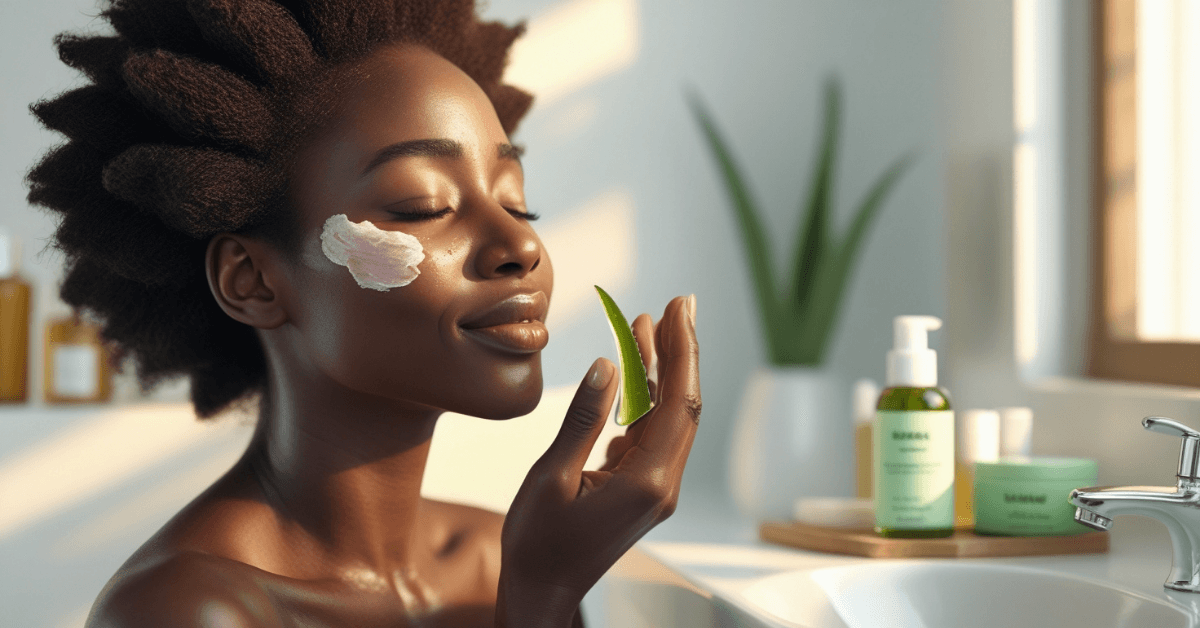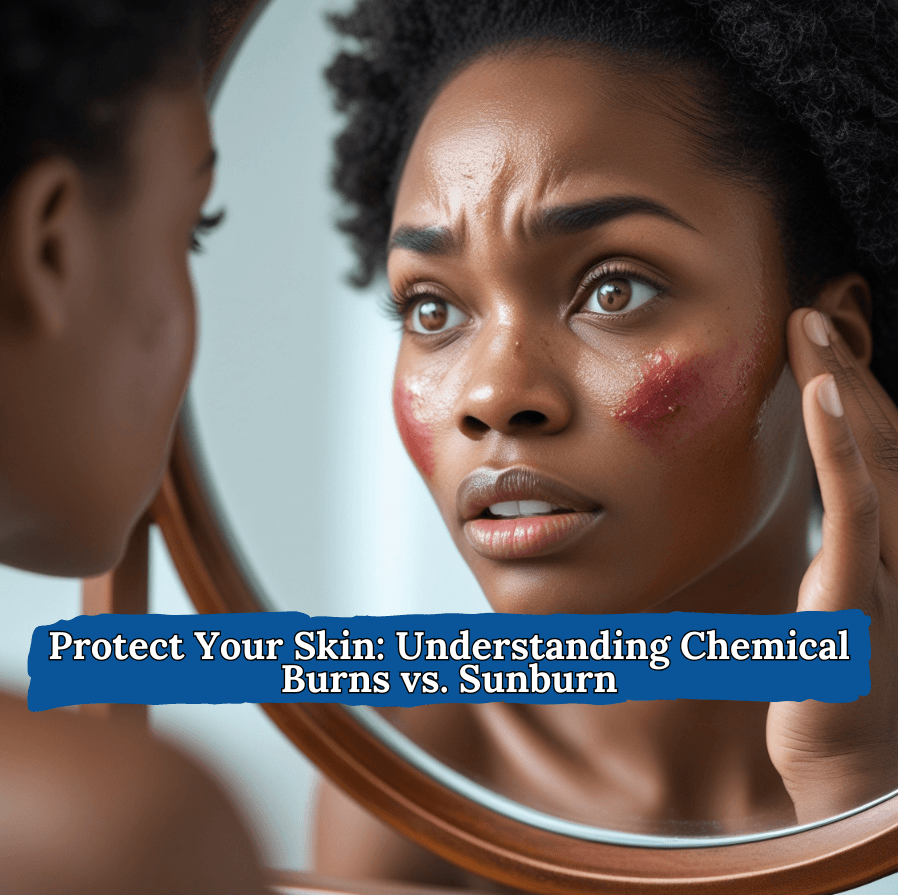Understanding Skin Burns
Skin burns can result from various causes, including harsh chemicals and excessive sun exposure. Chemical burns from bleaching products and sunburn are two distinct types of skin damage, but both can lead to serious complications if not treated properly. Understanding their differences, risks, and treatments is essential for maintaining healthy skin and preventing long-term damage.
Chemical Burns from Bleaching Products
Causes and Mechanism
Chemical burns occur when harsh substances damage the skin, leading to irritation, inflammation, and, in severe cases, deep tissue damage. Skin-bleaching products often contain strong chemicals like hydroquinone, mercury, corticosteroids, and high concentrations of hydrogen peroxide or sodium hydroxide, which can cause burns if misused.
Common causes include:
- Overuse or high concentration of bleaching agents.
- Prolonged exposure of the chemical on the skin.
- Applying on sensitive or broken skin.
- Allergic reactions to ingredients.
- Mixing bleaching products with other harsh chemicals, creating a more aggressive reaction.
Symptoms of Chemical Burns
- Redness and inflammation.
- Burning or stinging sensation.
- Blisters or peeling skin.
- Skin darkening (post-inflammatory hyperpigmentation) or lightening (hypopigmentation).
- Pain and tenderness.
- Scarring in severe cases.
Dangers of Chemical Burns from Bleaching Products
- Permanent Skin Damage – Excessive use can lead to irreversible thinning of the skin, making it fragile and prone to tears.
- Hyperpigmentation and Hypopigmentation – Instead of achieving even skin tone, some burns cause dark spots or uneven light patches.
- Increased Skin Sensitivity – Damaged skin is more prone to irritation, infections, and sunburn.
- Toxicity Risks – Some bleaching agents, such as mercury, can enter the bloodstream and cause systemic damage to the nervous and renal systems.
Treatment for Chemical Burns from Bleaching Products

Immediate Care
- Rinse with cool water for at least 10–15 minutes to remove residual chemicals.
- Avoid scrubbing or rubbing the affected area to prevent further damage.
- Apply a gentle, fragrance-free moisturizer or aloe vera gel to soothe the skin.
- Use over-the-counter hydrocortisone cream to reduce inflammation.
Medical Treatment for Severe Burns
- If blisters, open wounds, or severe pain occur, seek medical attention immediately.
- A doctor may prescribe antibiotic creams or steroid treatments to aid healing.
- In extreme cases, laser therapy or chemical peels might be needed to correct hyperpigmentation or scarring.
Long-Term Care
- Avoid using bleaching products until the skin fully recovers.
- Always apply broad-spectrum sunscreen (SPF 30 or higher) to protect the damaged skin from further harm.
- Use gentle skincare products without harsh chemicals or fragrances.
Image Prompt: A Black woman applying aloe vera gel to a visibly irritated area on her face.
Sunburn

Causes and Mechanism
Sunburn occurs when the skin is overexposed to ultraviolet (UV) radiation from the sun or tanning beds. UV rays damage skin cells’ DNA, leading to inflammation and the release of chemicals that cause pain and redness.
Common causes include:
- Extended time in direct sunlight without protection.
- Exposure to strong UV rays between 10 AM – 4 PM.
- Not wearing sunscreen or using low SPF.
- Reflective surfaces (like water, sand, and snow) intensifying UV exposure.
Symptoms of Sunburn
- Red, inflamed skin (mild to severe).
- Pain or tenderness.
- Warm or hot sensation on the skin.
- Blisters in severe cases.
- Peeling skin as it heals.
- Dehydration and fatigue in extreme cases.
Dangers of Sunburn
- Premature Aging – Repeated sunburns accelerate wrinkles, fine lines, and sagging due to collagen breakdown.
- Hyperpigmentation & Uneven Skin Tone – Sunburn can darken scars, freckles, and cause sunspots.
- Skin Cancer Risk – UV damage increases the risk of melanoma, the deadliest form of skin cancer.
- Weakened Immune System – Severe burns can suppress the skin’s ability to heal and fight infections.
Treatment for Sunburn
Immediate Care
- Move to shade or indoors immediately.
- Cool the skin by taking a lukewarm shower or using cold compresses.
- Apply soothing agents like aloe vera gel, cucumber, or yogurt.
- Stay hydrated by drinking plenty of water to prevent dehydration.
- Use pain relievers like ibuprofen or aspirin to reduce swelling and discomfort.
Medical Treatment for Severe Sunburn
- If blisters, fever, dizziness, or nausea occur, seek medical help.
- Doctors may prescribe topical steroids or burn creams for severe cases.
- IV fluids might be necessary if dehydration is severe.
Long-Term Care
- Avoid further sun exposure until the skin heals.
- Wear protective clothing, hats, and sunglasses.
- Apply broad-spectrum SPF 50 sunscreen daily to prevent future burns.
Image Prompt: A Black man wearing a wide-brimmed hat and sunglasses, applying sunscreen to his face while outdoors.
Also Read:
- Why DEET Repellent is Essential for Travelers and Residents in High-Risk Countries
- DEET vs. DEET-Free Mosquito Repellents: Benefits, Differences, and How to Choose the Right One
- The Difference Between Chemical Burns from Bleaching Products and Sunburn: Dangers and Treatments
- Glycolic Acid vs. Salicylic Acid: Understanding the Key Differences
- Dangers of Skin Bleaching
Key Differences Between Chemical Burns and Sunburn
| Feature | Chemical Burns (Bleaching Products) | Sunburn |
|---|---|---|
| Cause | Harsh chemicals (e.g., hydroquinone, mercury, hydrogen peroxide). | UV radiation from the sun. |
| Onset | Immediate to a few hours after application. | A few hours after sun exposure. |
| Symptoms | Burning, redness, blisters, discoloration. | Redness, pain, warmth, peeling. |
| Long-Term Effects | Scarring, hyperpigmentation, skin thinning. | Premature aging, sunspots, skin cancer risk. |
| Treatment | Flush with water, apply soothing creams, avoid harsh chemicals. | Cool skin, hydrate, use aloe vera and pain relievers. |
Conclusion
Both chemical burns from bleaching products and sunburn can cause significant damage to the skin, but they have different causes and risks. Chemical burns result from harsh ingredients that strip and damage the skin, often leading to long-term discoloration and sensitivity. Sunburn, on the other hand, is caused by UV radiation and increases the risk of premature aging and skin cancer.
Proper prevention and treatment are crucial for both types of burns. Avoid harsh skin-bleaching agents and always patch-test new products before use. Similarly, protect your skin from the sun by applying sunscreen and wearing protective clothing. If burns occur, immediate care and long-term skin repair strategies can help minimize damage and restore skin health.
What is the main difference between chemical burns and sunburn?
Chemical burns result from exposure to harsh substances like bleaching agents, while sunburn is caused by UV radiation from the sun. Chemical burns can occur immediately upon contact, whereas sunburn develops a few hours after sun exposure.
Can chemical burns from bleaching products be permanent?
Yes, severe chemical burns can cause permanent skin damage, including scarring, hyperpigmentation, or hypopigmentation. Prolonged use of harsh bleaching agents may also lead to skin thinning and increased sensitivity.
How can I treat a chemical burn from skin-bleaching products?
Immediately rinse the affected area with cool water for 10–15 minutes, apply a fragrance-free moisturizer or aloe vera, and avoid further use of bleaching products. If severe symptoms like blisters or open wounds develop, seek medical attention.
What are the long-term effects of sunburn?
Repeated sunburns can lead to premature aging, hyperpigmentation, sunspots, and an increased risk of skin cancer, particularly melanoma. Severe sunburns can also weaken the immune system and cause long-term skin damage.
How can I prevent sunburn?
To prevent sunburn, apply broad-spectrum sunscreen with SPF 50 daily, wear protective clothing, and avoid direct sunlight during peak hours (10 AM – 4 PM). Reapply sunscreen every two hours, especially if swimming or sweating.
Can sunscreen prevent chemical burns from bleaching products?
No, sunscreen does not protect against chemical burns. However, if you’ve experienced a chemical burn, applying sunscreen can prevent further sun damage and reduce hyperpigmentation during the healing process.
Is it safe to use skin-bleaching products?
Some skin-lightening products can be safe if used correctly and under dermatological supervision. However, products containing mercury, hydroquinone, or corticosteroids should be used cautiously, as they can cause severe side effects, including chemical burns and long-term skin damage.
Let me know if you’d like any adjustments or additional FAQs!




